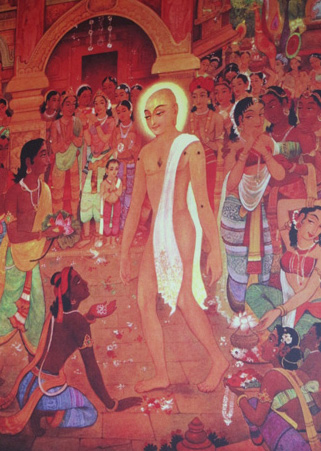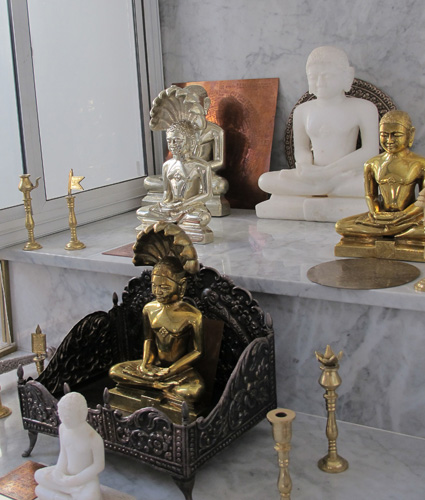3 Feb
Ruth writes: When I was in India over a decade ago, I saw several men
wearing rectangular white masks over their noses. They were dressed in white
robes. As they walked along the streets with brooms, they gently swept
the ground in front of their bare feet. They were Shwetambar Jain
monks trying to avoid killing living organisms — like insects. They
were amazing.
Then I heard about another sect of Jain monks called Digambar.
These men did not even wear clothes. They were trying to use as little
of the earth’s resources as possible. They still do not use vehicles,
telephones, or electricity. They avoid world possessions.
I admired their idealism. Today we too are concerned about carbon
footprints. The Jain religion began in India at least 5000 years ago.
About 6000 Jains live in Toronto today. The walls of their temple are
covered with pictures of their spiritual teachers such as Mahavira.
Like Buddhism’s Prince Siddartha, Mahavira gave up a life of luxury to
search for the reason for human suffering and existence. Mahavira also
spent years travelling, meditating, fasting and teaching. Jains live an austere
life so they can escape the endless cycle of birth and reincarnation.
Last week I visited a Jain temple in Etobicoke. Pictures of Mahavira’s life were on the walls.
Captions were in English, Hindi and Gujarati. Most Indian Jains speak Hindi,
said Kirti Shah, a member of the Jain Society who was showing me around.
Prominently placed in the former Anglican church building was a large
mural of the 24 Bhagwan Tirthankaras or religious teachers of whom
Mahavira was the last. Shah explained that they were all equal but
some are more popular with worshippers than others. They were all
male, said Kirti though some Swetambar Jains believe that one was female.
Kirti led me to a chapel called the Derasar where one altar had three
statues of the Tirthankaras of the Svetambara sect. These role-models
are not worshipped or petitioned. Rather, Jains pay homage to them as
teachers and hope that these teachers will inspire them to follow the
five Jain principles of non-violence, truthfulness, non-stealing,
celibacy, and non-possessiveness within their current practical
limitations.
At another altar were statues of monks from the Digambara sect. The
monks of this sect don’t wear clothes and believe only males can reach
nirvana or extinction. I thought it exemplary that members of
differing sects could worship in the same room and work peacefully
together.
Kirti is not a monk. He admires people who live as simply as possible.
He showed me the poster he was promoting. I had seen it recently
around Toronto. On it was “Why do we love dogs but eat pigs who are also
loveable, intelligent, and social?” It is a good question. Most Jains
are vegetarian and do not even eat root vegetables because they believe these vegetables contain multiple lives.
The symbol of Jainism includes a swastika, a Sanskrit word that means
“auspicious.” It too is at least 5000 years old.
Near the front door was a model of the Jain temple and community
centre which should be open at Ellesmere Road and Warden Avenue in a
few years. Kirti said it will be 55,000 square feet. The Jain
population of Toronto is growing quickly from immigration and needs
the space. It will help keep their ideals alive.
The current temple is at 48 Rosemeade Avenue with a membership of a thousand families. Telephone 416-251-8112. Its email is info@isotcanada.org. Its website: http://www.jsotcanada.org/ .









Kirti Shah writes to Ruth: One important correction. It is not true that all or most Jains speak
Gujarati. Jains in many states speak Hindi. About 40% of Jains speak Hindi.
Also, I do not live a simple lifestyle but admire those who do.
Other than this, the blog is very good and largely accurate.
Excellent article and very interesting. Inspiring as well. Thank you.
Thanks Rita. Sorry you couldn’t join me. There’ll be other opportunities in the future. Ruth.